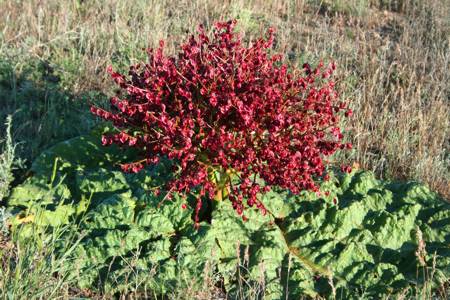Relatives
Rheum tataricum L. - Rhubard Tatar.
Taxonomic position.
Family Polygonacea Juss. Genus Rheum L.Morphology and biology.
A perennial plant. A rhizome is vertical, strong. There are usually 2-3 stems on a plant which are branching from the middle part of stem under a corner 40 degree. Stems are hollow, strong, furrowed, naked. Leaves up to 35 cm in length and 50 cm in width, round, with the heart-shaped basis and three oustanding nerves. Leaf-stalks are short, covered by small fibers. Leaves from above are naked, from below are covered by small fibers. Flowers are yellowish, 3 mm in length, with 3-5 brown nerves, every flower has 5 identical shares of perianth. Fruits have 10-12 mm in length, 8-10 mm in width. Nutlets have back-ovate forms, dark-brown, finely wrinkled; wings are narrow 1-1,5 mm of width, darkly-redish-brown, up narrowed, with nerve on the edge of a wing. Shares of perianth are pressed to a fruit. Blossoms in April - May, fructifies in May - June. Anemophilous. Anemochore.Distribution.
The general distribution: Endem of the Middle Asia; area Zavolzhsky of the European part of Russia. In territory of former USSR: the European part: area Zavolzhsky. Middle Asia - Aral-Caspian and Pribalhashsky region.Ecology.
In steppes, on rubble, clay, on salted soil, on grassy and dry slopes.Use and economic value.
The wild relative of a cultivated rhubarb. It is used in crossings for creation of variaties, undemanding to soils and a drought.Related References:
Cherepanov, S.K. 1995. Plantae Vasculares Rossicae et Civitatum Collimitanearum (in limicis USSR olim). St-Petersburg, "Mir I Semia", 990 p. (in Russian).Flora USSR, 1936. Vol. 5. V.L. Komarov (ed.) M.-L.: Publishing House of Acad. Science, pp. 489-490. (in Russian).
Manual of plants of Middle Asia. Critical synopsis of flora. Vol. 2. S.S.Kovalevskaja (ed.). Tashkent, pp. 172. (in Russian).


